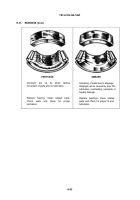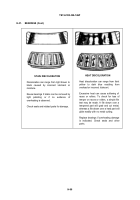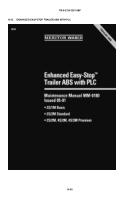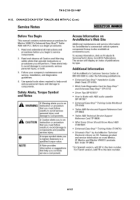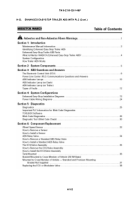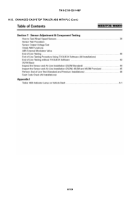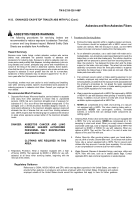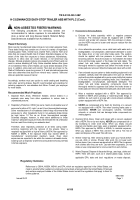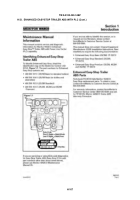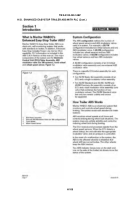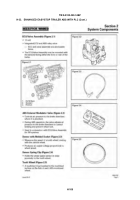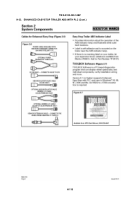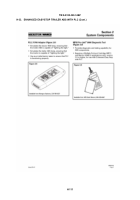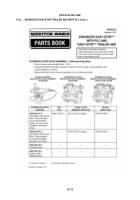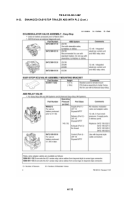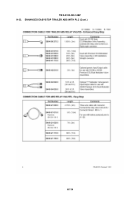TM-9-2330-326-14-P - Page 359 of 540
TM 9-2330-326-14&P
H-105
H-33. ENHANCED EASY-STOP TRAILER ABS WITH PLC (Cont.)
Asbestos and Non-Asbestos Fibers
ASBESTOS FIBERS WARNING:
The
following
procedures
for
servicing
brakes
are
recommended to reduce exposure to asbestos ?ber dust,
a cancer and lung disease hazard. Material Safety Data
Sheets are available from ArvinMeritor.
Hazard Summary
Because some brake linings contain asbestos, workers who service
brakes
must
understand
the
potential
hazards
of
asbestos
and
precautions for reducing risks. Exposure to airborne asbestos dust can
cause serious and possibly fatal diseases, including asbestosis (a chronic
lung disease) and cancer, principally lung cancer and mesothelioma (a
cancer of the lining of the chest or abdominal cavities). Some studies
show that the risk of lung cancer among persons who smoke and who are
exposed to asbestos is much greater than the risk for non-smokers.
Symptoms of these diseases may not become apparent for 15, 20 or
more years after the ?rst exposure to asbestos.
Accordingly, workers must use caution to avoid creating and breathing
dust when servicing brakes. Speci?c recommended work practices for
reducing exposure to asbestos dust follow. Consult your employer for
more details.
Recommended Work Practices
1. Separate Work Areas. Whenever feasible, service brakes in a separate
area away from other operations to reduce risks to unprotected
persons. OSHA has set a maximum allowable level of exposure for
asbestos of 0.1 f/cc as an 8-hour time-weighted average and 1.0 f/cc
averaged over a 30-minute period. Scientists disagree, however, to
what extent adherence to the maximum allowable exposure levels will
eliminate the risk of disease that can result from inhaling asbestos
dust. OSHA requires that the following sign be posted at the entrance
to areas where exposures exceed either of the maximum allowable
levels:
DANGER:
ASBESTOS
CANCER
AND
LUNG
DISEASE
HAZARD
AUTHORIZED
PERSONNEL
ONLY
RESPIRATORS
AND PROTECTIVE
CLOTHING ARE REQUIRED IN THIS
AREA.
2. Respiratory Protection. Wear a respirator equipped with a high-
ef?ciency (HEPA) ?lter approved by NIOSH or MSHA for use with
asbestos at all times when servicing brakes, beginning with the
removal of the wheels.
3. Procedures for Servicing Brakes.
a. Enclose the brake assembly within a negative pressure enclosure.
The enclosure should be equipped with a HEPA vacuum and
worker arm sleeves. With the enclosure in place, use the HEPA
vacuum to loosen and vacuum residue from the brake parts.
b. As an alternative procedure, use a catch basin with water and a
biodegradable, non-phosphate, water-based detergent to wash the
brake drum or rotor and other brake parts. The solution should be
applied with low pressure to prevent dust from becoming airborne.
Allow the solution to ?ow between the brake drum and the brake
support or the brake rotor and caliper. The wheel hub and brake
assembly components should be thoroughly wetted to suppress
dust before the brake shoes or brake pads are removed. Wipe the
brake parts clean with a cloth.
c. If an enclosed vacuum system or brake washing equipment is not
available, employers may adopt their own written procedures for
servicing brakes, provided that the exposure levels associated with
the employer’s procedures do not exceed the levels associated
with the enclosed vacuum system or brake washing equipment.
Consult OSHA regulations for more details.
d. Wear a respirator equipped with a HEPA ?lter approved by NIOSH
or MSHA for use with asbestos when grinding or machining brake
linings. In addition, do such work in an area with a local exhaust
ventilation system equipped with a HEPA ?lter.
e.
NEVER
use compressed air by itself, dry brus hing, or a vacuum
not equipped with a HEPA ?lter when cleaning brake parts or
assemblies.
NEVER
use
carcinogenic
solvents,
?ammable
solvents, or solvents that can damage brake components as
wetting agents.
4.
Cleaning Work Areas. Clean work areas with a vacuum equipped with
a HEPA ?lter or by wet wiping.
NEVER
use compressed air or dry
sweeping to clean work areas. When you empty vacuum cleaners
and handle used rags, wear a respirator equipped with a HEPA ?lter
approved by NIOSH or MSHA for use with asbestos. When you
replace a HEPA ?lter, wet the ?lter with a ?ne mist of water and
dispose of the used ?lter with care.
5.
Worker Clean-Up
.
After servicing brakes, wash your hands before
you eat, drink or smoke. Shower after work. Do not wear work clothes
home. Use a vacuum equipped with a HEPA ?lter to vacuum work
clothes after they are worn. Launder them separately. Do not shake
or use compressed air to remove dust from work clothes.
6.
Waste Disposal. Dispose of discarded linings, used rags, cloths and
HEPA ?lters with care, such as in sealed plastic bags. Consult
applicable EPA, state and local regulations on waste disposal.
Regulatory Guidance
References to OSHA, NIOSH, MSHA, and EPA, which are regulatory agencies in the United States, are made to
provide further guidance to employers and workers employed within the United States. Employers and workers
employed outside of the United States should consult the regulations that apply to them for further guidance.
Back to Top

